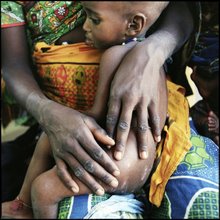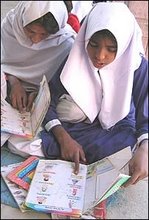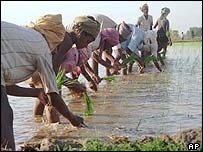Preamble: The cost of malnutrition to the global economy in
lost productivity and health care costs accounts for as much as 5% of the
global GDP - $3.5 trillion dollars, or $500 per person. That is almost the
entire annual GDP of Germany, Europe's largest economy. In social terms, child and maternal
malnutrition continue to reduce the quality of life and life expectancy of
millions of people, while obesity-related health problems, such as heart
disease and diabetes, affect millions more.
In this month’s issue, we
focus on two items:
1. A report recently released by the United Nation’s
Food and Agricultural Organization (FAO 2013), entitled “Food systems for better nutrition” which
notes that that improved food systems
can make food more affordable, diverse and nutritious.
2. A Case Study of the System of Rice Intensification (SRI)
1. FOOD
SYSTEMS FOR BETTER NUTRITION
This FAO report notes that some 870 million people were
still hungry in the world in 2010-2012; this is a fraction of the billions of
people whose health, wellbeing and lives are blighted by malnutrition. Two
billion people suffer from one or more micronutrient deficiencies, while 1.4
billion are overweight, of whom 500 million are obese. Twenty six percent of
all children under five are stunted and 31% suffer from Vitamin A deficiency.
To combat malnutrition, the report makes the case that
healthy diets and good nutrition must start with food and agriculture. The way
we grow, raise, process, transport and distribute food influences what we eat,
the report says, noting that improved food systems can make food more
affordable, diverse and nutritious.
Specific
recommendations for action include:
• Use
appropriate agricultural policies, investment and research to increase
productivity, not only of staples like maize, rice and wheat, but also of
legumes, meat, milk, vegetables and fruit.
• Cut food
losses and waste, which currently amount to one third of the food produced for
human consumption every year, thus increasing availability and affordability as
well as reducing pressure on land and other resources.
• Improve
the nutritional performance of supply chains, enhancing the availability and
accessibility of a wide diversity of foods. Properly organized food systems are
key to more diversified and healthy diets.
• Help
consumers make good dietary choices for better nutrition through education,
information and other actions.
• Improve
the nutritional quality of foods through fortification and reformulation.
• Make food
systems more responsive to the needs of mothers and young children.
Malnutrition during the critical ‘first 1000 days' from conception can cause
lasting damage to women's health and life-long physical and cognitive
impairment in children.
Women's role
Giving women greater control over resources and incomes
benefits their and their children's health, the report says. Policies,
interventions and investment in labour-saving farming technologies and rural
infrastructure, as well as social protection and services can also make
important contributions to the health and nutrition of women, infants and young
children.
Projects that have proved successful in raising nutrition
levels include enhanced production, marketing and consumption of local
vegetables and pulses in East Africa; promotion of home gardens in West Africa;
encouragement of mixed vegetable and animal farming systems together with
income-generating activities in some Asian countries; breeding staple crops
such as sweet potatoes to raise their micronutrient content; and public-private
partnerships to enrich products like yoghurt or cooking oil with nutrients.
Source: Food and
Agriculture Organization of the United Nations (FAO). The State of Food and
Agriculture – Food Systems for Better Nutrition. ISSN 0081-4539 Rome
2013. http://bit.ly/14sqU2I
2. A CASE STUDY OF THE SYSTEM OF RICE
INTENSIFICATION (SRI)
Rice, a
cereal crop that belongs to the family of plants that includes wheat and corn, is
a staple food for over half of the world’s population. The nutrient content of rice varies based on factors
such as: strain and variety (whether white, brown, black, red and purple); soil
quality; if the grain is polished or processed; if it is enriched; and preparation
before consumption.
Rice has
fed more people over a longer period than has any other crop; evidence of production across Asia dates from
over 10,000 years. Two species of rice are important to humans: Oryza
sativa, grown worldwide; and Oryza glaberrima, grown in parts of
West Africa. The International Rice Genebank contains more than 112,000 species,
including wild rice, the ancestors of rice, traditional and heirloom varieties,
and modern varieties.
Rice is
unique, growing in wet environments where other crops cannot survive. The
combined forces of natural and human selection of varieties, diverse
climates, seasons, and soils, and different cultural practices have led to a
wide ecological range for rice, especially in Asia, where 90% of the world’s
rice is grown. Rice-based farming is the main economic activity for
hundreds of millions of rural poor in this region.
Irrigated
lowland rice is the only crop that can be grown continuously without need for
rotation, and can produce up to three harvests a year—literally for centuries,
on the same plot of land. Farmers also grow rice in rain-fed lowlands, uplands,
mangroves, and deep-water areas.
In Africa, where
rice is produced and eaten in 38 countries, rice is the fastest growing staple,
reaching 10 million tons in 2008, and costing an estimated $3.6 billion for
imports. Rice is also one of the fastest growing staple foods in Latin America,
especially among urban consumers and particularly the poor. The region is a net
importer of rice, with a projected annual deficit of 4 million tons by 2015.
For many in
the developing world, rice means food security: they are extremely vulnerable
to price increases, even if short-term. Changes in rice availability have
caused far-reaching social unrest in several countries. The challenge in producing
additional rice involves using less land, less water, and less labour, in more
efficient, environmentally-friendly production systems that are more resilient
to climate change. For extremely poor people (less than $1.25/day), rice
accounts for nearly half of food expenditures and a fifth of total household
expenditures, on average.
The System of Rice Intensification (SRI) - is
a climate-smart, agro-ecological methodology for increasing the productivity of
rice and more recently other crops. It was synthesized in the 1980s by Fr. Henri de Laulanié, S.J., who
came to Madagascar from France in 1961 and worked with Malagasy farmers to
improve their agricultural systems, particularly rice production, the staple
food in Madagascar. After introduction,
farmers using SRI methods averaged 8 tons/hectare, better than the 2
tons/hectare previously produced on the limited lowland agricultural area. The
increased rice yield reduced the need for farmers to expand rice growing into
the upland rain forest ecosystems, reducing forest destruction from
slash-and-burn agriculture.
SRI was
promoted globally by Norman Uphoff, then director of the International Institute for Food,
Agriculture and Development at Cornell
University (CIIFAD), New York, after its success in
Madagascar was observed for a number of years.
SRI methodology is based on four main principles that
interact with each other:
- Early, quick and healthy plant
establishment
- Reduced plant density
- Improved soil conditions through
enrichment with organic matter
- Reduced and controlled water
application
Based on these principles,
farmers can adapt recommended SRI practices
to respond to their agro-ecological and socioeconomic conditions. Adaptations
are often undertaken to accommodate changing weather patterns, soil conditions,
labor availability, water control, access to organic inputs, and the decision
whether to practice fully organic agriculture or not. In addition to irrigated
rice, the SRI principles have been applied to rain-fed rice and to other crops, such as wheat, sugarcane, teff, finger millet, pulses,
showing increased productivity over current conventional planting practices.
SRI principles applied to other crops is referred to as the System of Crop
Intensification or SCI.
The benefits of SRI
use include: increased yield, water conservation, reduced production costs, and
increased income. However, it is unclear how much better SRI is at delivering
increased yield and other gains to rice farmers, such as healthier soils, when
compared with established recommended best management practices for rice production. According to the IRRI, "The flexibility in
SRI’s definition of practices renders SRI a challenge for evaluation and assessment
of adoption."; this implies difficulty in evaluation, with
critics claiming a lack of details on methodology used in trials, and few
peer-reviewed publications.
References:
International Rice Research Institute (IRRI) website.
Accessed June 14, 2013.http://irri.org/index.php?option=com_k2&view=item&id=9081:rice-basics&lang=en
SRI Rice – System of Rice Intensification. Website. with support from
Jim Carrey's Better U Foundation and the Cornell International Institute for Food, Agriculture and Development http://sri.ciifad.cornell.edu/ Accessed June 14, 2013.
Jim Carrey's Better U Foundation and the Cornell International Institute for Food, Agriculture and Development http://sri.ciifad.cornell.edu/ Accessed June 14, 2013.
Improving rice
technology is not without its controversies. Below is a synopsis of online article in the Guardian newspaper on SRI-derived
harvests in Bihar, India (http://www.guardian.co.uk/world/2013/feb/23/india-rice-revolution-questioned):
“Professor Yuan
Longping, director-general of China's national rice research centre and known
as the "father of rice" in his country, doubted the claim of a world
record harvest by a young Indian farmer Sumant Kumar: in 2011, 22.4 tonnes of
rice from one hectare of land in Bihar, farmed using SRI methods. The previous
record was 19.4 tonnes a hectare, held by Yuan.
However, Norman
Uphoff, professor of agriculture at Cornell University (USA), defended the
measurements taken of Kumar’s yield by both the Indian Council for Agricultural
Research and the Ministry of Agriculture. "The measurements were made by staking
out 10X5 metre plots….., not sampled crop-cuts from small areas. The 50 square
metre plots were harvested with hundreds of people watching …. These results
were achieved with hybrid varieties which derive from Yuan's own innovation of
hybridizing rice, considered for decades by most rice scientists to be
impossible. " he said.
Earlier this
year, the government of Bihar, where nearly half the population of 100 million
live below the poverty line and 93% depend on growing rice and potatoes,
endorsed SRI, saying its rice production increased to a record 8.2m tonnes last
year, against 3.1m tonnes in 2010-11. Claims of higher yields (and a world
record) for potatoes have been made also in the Nalanda district.
Amir Kassam,
former director of the Consultative Group on International Agricultural
Research's Science Council at the UN's Food and Agriculture Organization, said
that many people still doubt the success of SRI. "There are now close to a
million hectares under SRI and that cannot be regarded as a delusion. It is
real." Professor Robert Chambers of
the Institute of Development Studies at Sussex University said "SRI is an
astonishing win-win for farmers and the environment. Some scientists have been
slow to recognize it, ….., but its success and spread have been
phenomenal." “


























